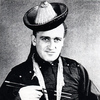Chinese Buddhist Monasteries: Their Plan and Its Function as a Setting for Buddhist Monastic Life, Johannes Prip-Møller.
Copenhagen : G.E.C. Gads Forlag, 1937. Hardcover. Table of contents; Preface; I. The typical Buddhist monastery layout of today: - Central axis; II. Buddhist monastery layout of today: Lateral groups; III. The monastery of Hui Chü Ssu, Pao Hua Shan, Kiangsu; IV. Buddhist History of Hui Chü Ssu, Pao Hua Shan, Kiangsu; V. The ordination unit, its ceremonies and its developments; VI. Monks' offices and daily life in the monasteries; Table of Sketches; Table of Plates; Alphabetical index; Table of monasteries; Chinese dynasties; Notes on Illustrations; Errata. Pocket in back with 3 fold out diagrams 29 1/2 by 21 inches. The book has 365 numbered B&W plates and sketches, some on fold out pages. There is a colored front piece of the Interior of the 500 Lo Han T'ang, and a woodcut reproduced from the Pao Hua Shan Chronicle. ix + 396 pages.
Provenance: Formerly in the collection of Danish Archaeologist, Ethnographer, Art Collector and Museum Director Werner Jacobsen (1914-79). For more information, see below.
Säljes i befintligt skick.
Proveniens
Formerly in the collection of Danish Archaeologist, Ethnographer, Art Collector and Museum Director Werner Jacobsen (1914-79). Jacobsen studied archeology and participated 1938-39 in the Danish Royal Geografic Societys Expedition to Mongolia under the lead of Henning Haslund-Christensens.
During the years 1946-59 he lived in India and Nepal and acquired many pieces for National Museum in Denmark, The Royal Library, the Moesgård Museum and himself. He set up a scientific center in Kathmandu, Nepal and later in Denmark where he organized all the material and information he had gathered.
In 1940-45 he was employed the Danish National Museum, in 1961 he became Museum Director for the Etnografic Collection. 1963-78 he was the head of the information and educational Department at the Museum. The collection was acquired from Werner Jacobsen as a whole when he sold it to gather funds for new expeditions. Thence by descent to the present owner.
Litteratur
Werner Jacobsen published various literary and academic works such as; Bronzer fra Mongoliet, Köpenhamn, 1940, Some Observations on the Origin of Sino-sibirian Animal Bronzes, Köpenhamn 1941, Buddhsitisk Skulptur I Kina, Köpenhamn, 1941, Kabuki, det Japanska folks teater, Köpenhamn 1941, Todaerne, - en idisk bjergstamme, Köpenhamn 1949, Maleri fra Puri, Orissa, Indien, Köpenhamn 1961, Thailand, Arkeologi og Kunst, Köpenhamn 1961. Originale Bloktryk fra Nepal, Köpehamn, 1966, Asiatiske Akkorder, Köpenhamn 1965, Buddha og det modern menneske, Köpenhamn, 1970, Kunsten, kunstneren og inderen, Köpenhamn, 1970, Den hvide mans byrde, Köpenhamn, 1970, Hvad er den egentlige virkelighed, Köpenhamn, 1976, Den hvide gud, Köpenhamn, 1973.
Övrig information
The author, a Danish architect, travelled throughout China from 1929 to 1933, studying and living in various monasteries in eleven provinces. Four years further work on the photographs, architectural plans, drawings and notes produced this volume on Buddhist monasteries and monastic life in China.







































